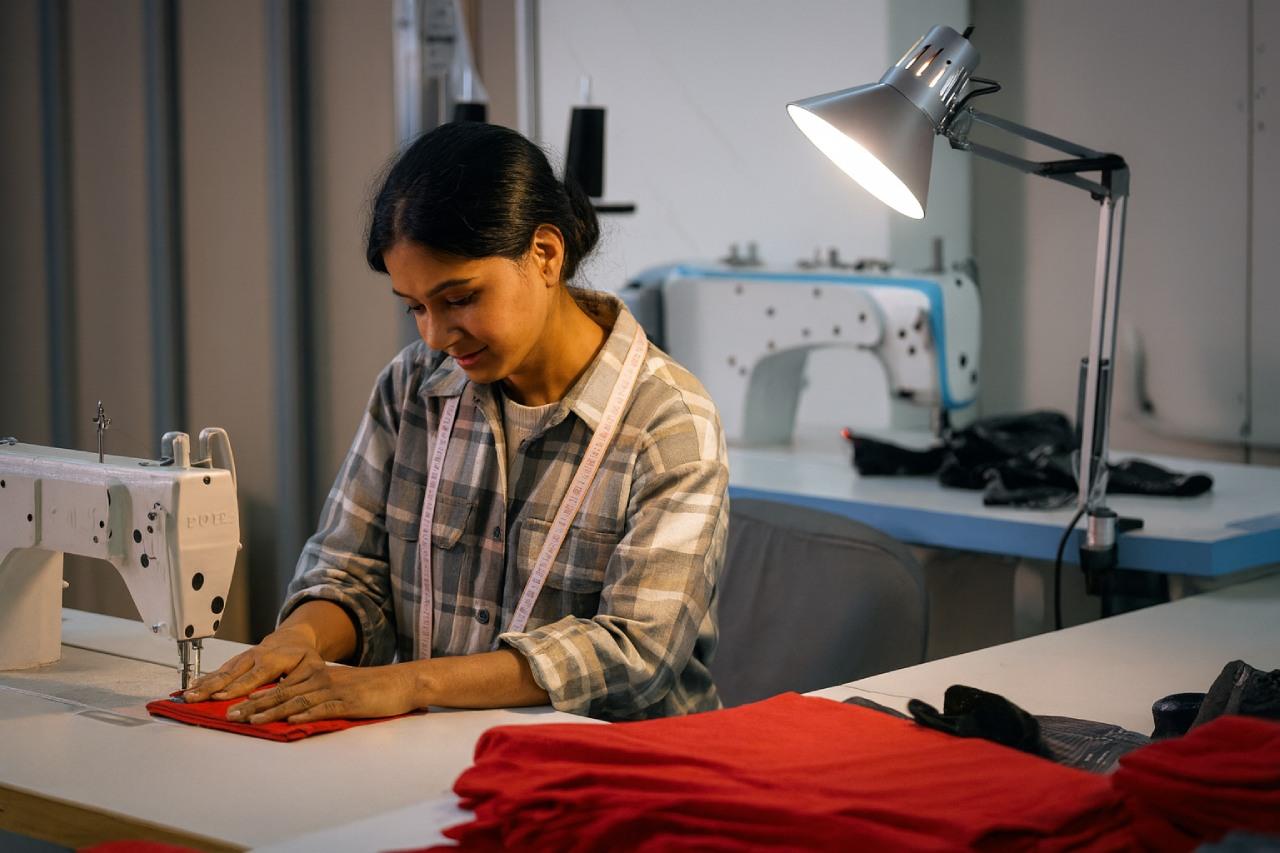With a share of 4.6 per cent of the global trade in textiles and apparel, the textile industry plays a crucial role in India’s economic growth and generating employment for women. In handloom industry itself, about 35.2 lakh handloom workers were employed across the country, with women workers constituting 72.3 per cent share (Handloom Census 2019−20)1. The indicative figure for power loom sector suggests about 60-70 per cent of the women workforce. Majority of the women workers in the textile industry are still a part of the unorganised sector and are engaged in the allied activities. Reasons could be low wages, long working hours, tedious working conditions, health hazards, use of heavy machineries, spatial mismatch, and lack of required skills.
With schemes like Pradhan Mantri Mega Integrated Textile Region and Apparel (PM-MITRA)2, the Indian government has tried to enhance women’s participation in the textile industry by creating an ecosystem that fosters gender equality, but despite that gender gap remains. The MSDE-NCAER (2025) study ‘National Skill Gap Study for High Growth Sectors’3 found while nearly 43 per cent of total workers engaged in ‘weaving of textiles’ sector were women; it constituted nearly 100 per cent in the North-Eastern region (PLFS 2022-23). Majority of women workers had received vocational/ technical training, but 70 per cent of them had received informal training.
Of total workforce in the textile weaving segment, 67 per cent were handloom workers, 12.4 per cent ‘textile, fur and leather products machine operators’ and 8 per cent ‘garment and related trades’ workers. Within these key job roles, females have more predominance in ‘handloom workers’ (79 per cent compared to 58 per cent males) and garment and related trades workers’ (11.3 per cent vs 5.5 per cent males). Comparatively, after ‘handloom workers’, males are highly involved in job roles like ‘textile, fur and leather products machine operators’ (18.5 per cent vs 4.7 per cent females).
|
Job Roles of Textile Weaving Sector |
Total% |
Male% |
Female% |
|
Handloom Workers |
66.8 |
57.5 |
78.7 |
|
Textile, Fur and Leather Products Machine Operators |
12.4 |
18.5 |
4.7 |
|
Garment and Related Trades Workers |
8.0 |
5.5 |
11.3 |
|
Managing Directors and Chief Executives |
3.6 |
6.1 |
0.5 |
|
Manufacturing Labourers |
2.0 |
2.3 |
1.6 |
|
Mining, Manufacturing and Construction Supervisors |
1.4 |
2.4 |
0.2 |
|
Business Services and Administration Managers |
1.2 |
0.7 |
1.7 |
|
Others |
4.5 |
7.1 |
1.2 |
|
Total |
100.0 |
100.0 |
100.0 |
Of the total women workforce engaged in this sector, one-third were working as ‘helpers’ in household enterprises and 57.6 per cent as own account workers. Those working as regular salaried employees or wage labour were less than 10 per cent of the women workforce share in the sector.
A larger share of women workers was low to low-medium skilled (61 per cent) compared to the higher share of male workers being medium-high skilled to high skilled. The presence of women at senior positions in the sector like ‘Managing Directors and Chief Executives’ was small at 0.5 per cent compared to 6.1 per cent males.
Based on key stakeholder interactions, the study finds that in the ‘weaving of textile’ segment, there was huge demand for job roles like Weaver-Handloom (Jacquard/ Loin loom), Weaver-Powerloom and Weaving Assistants (handlooms). Women being not able to operate heavy handloom machinery and further due to long working hours and tedious work conditions, they were majorly restricted towards allied activities of dyeing, designing, stitching etc. Further, lower levels of schooling and technical education among women in this sector (56 per cent had basic literacy to middle level schooling, only 7.2 per cent had diploma/certificate or graduate and above degrees and 0.5 per cent with technical education) and attainment of informal vocational training limited them to these traditional activities only.
Bridging the Skill Divide in Traditional Textile Roles
However, with an advent of upcoming digital and sustainable technologies in textile sector, a change has come not only in the production process but also in the nature of textiles that are being produced (green, circular or recycled textiles). With these technologies, the textile industry is now not limited to the clothing industry but has extended beyond in areas like automobiles, civil engineering and construction, agriculture, healthcare, industrial safety, personal protection etc. These technologies and processes demand for new set of skills in manufacturing processes, application areas, and research & development, thereby unlocking huge scope for new aspirants.
To tap full potential, a dual approach with an industry aligned up-skilling and re-skilling initiatives needs to be adopted. For traditional sector like handlooms, where majority of women workers are own-account workers, focus should be more on basic entrepreneurial skills, and financial and marketing skills with certain level of digital literacy.
For the sunrise sub-sectors with new generation aspirants, there is a need to design new curriculums like creative designing, usage of new fabrics/yarns and technologies, automation and digital technologies, sustainable technologies (circular/ green/ recycled/ sustainable textiles), advanced materials, supply chain innovations, artificial intelligence and machine learning, and entrepreneurial training.
Preparing Women for the Textile Industry’s Digital and Green Transition
Particularly for women aspirants, there is a huge scope for skilling in computerised designing, ICT skills which use CAD technology, new computerised eco-friendly dyes, and green textiles. This approach will not only help in dealing with the skill shortage in the sector but will also encourage women to shift from traditional to new non-traditional job roles. There is also a need to design pathways that enable women to transition from traditional roles within the conventional parts of the sector to modern roles in emerging sunrise industries.
Disclaimer from the Authors: Views are personal and do not reflect that of NCAER.



